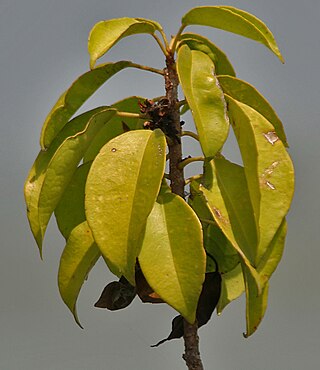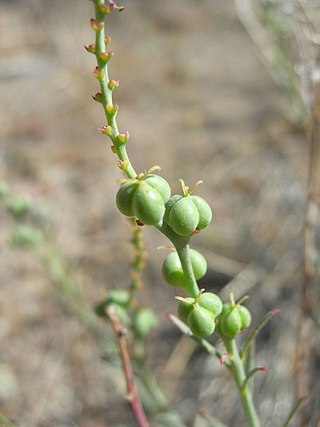
Sebastiania is a genus of flowering plants in the family Euphorbiaceae first described in 1821. It is native to North and South America from Arizona and the West Indies south to Uruguay.

Omphalea is a plant genus of the family Euphorbiaceae first described as a genus in 1759. It is native to tropical parts of the Americas, the West Indies, Asia, Australia, and Africa.

Excoecaria is a plant genus of the family Euphorbiaceae, formally described by Linnaeus in 1759. The genus is native to the Old World Tropics.

Stillingia is a plant genus of the family Euphorbiaceae, first described for modern science as a genus in 1767. The genus is native to Latin America, the southern United States, and various islands in the Pacific and Indian Oceans. Toothleaf is a common name for plants in this genus.
Actinostemon is a plant genus of the family Euphorbiaceae first described as a genus in 1841. It is native to South America, Central America, and the West Indies.

Gymnanthes is a genus of flowering plants in the spurge family, Euphorbiaceae, first described as a genus in 1788. It is found primarily in the warmer parts of the Western Hemisphere, but with some species in central Africa and southwestern Southeast Asia.

Microstachys is a genus of plants in the Euphorbiaceae first described as a genus in 1824. It is native to tropical Africa, southern Asia, Australia, Papuasia, Mesoamerica, the West Indies, and South America.
Sebastiania echinocarpa is a species of flowering plant in the family Euphorbiaceae. It was described in 1874. It is native to Bahia, Brazil.
Sebastiania eglandulata is a species of flowering plant in the family Euphorbiaceae. It was originally described as Omphalea eglandulataVell. in 1831. It is native to Rio de Janeiro, Brazil.
Sebastiania heteroica is a species of flowering plant in the family Euphorbiaceae. It was described in 1874. It is native to Rio de Janeiro, Brazil.
Sebastiania jacobinensis is a species of flowering plant in the family Euphorbiaceae. It was originally described as Gymnanthes jacobinensisMüll.Arg. in 1863. It is native to Bahia, Brazil.
Sebastiania longispicata is a species of flowering plant in the family Euphorbiaceae. It was described in 1912. It is native to Paraguay.
Sebastiania macrocarpa is a species of flowering plant in the family Euphorbiaceae. It was described in 1866. It is native to Ceará, Brazil.
Sebastiania panamensis is a species of flowering plant in the family Euphorbiaceae. It was described in 1988. It is native from Costa Rica to western Panama.
Sebastiania pteroclada is a species of flowering plant in the family Euphorbiaceae. It was originally described as Gymnanthes pterocladaMüll.Arg. in 1863. It is native to Rio de Janeiro, Brazil.
Sebastiania schottiana is a species of flowering plant in the family Euphorbiaceae. It was originally described as Gymnanthes schottianaMüll.Arg. in 1863. It is native from Brazil to northeastern Argentina.
Sebastiania potamophila is a species of flowering plant in the family Euphorbiaceae. It was originally described as Excoecaria potamophilaMüll.Arg. in 1874. It is native to Bahia, Brazil.
Sebastiania subulata is a species of flowering plant in the family Euphorbiaceae. It was originally described as Excoecaria subulataMüll.Arg. in 1874. It is native to Paraguay.
Sebastiania riedelii is a species of flowering plant in the family Euphorbiaceae. It was described in 1874. It is native to Minas Gerais, Brazil.
Sebastiania vestita is a species of flowering plant in the family Euphorbiaceae. It was described in 1874. It is native to Minas Gerais, Brazil.






